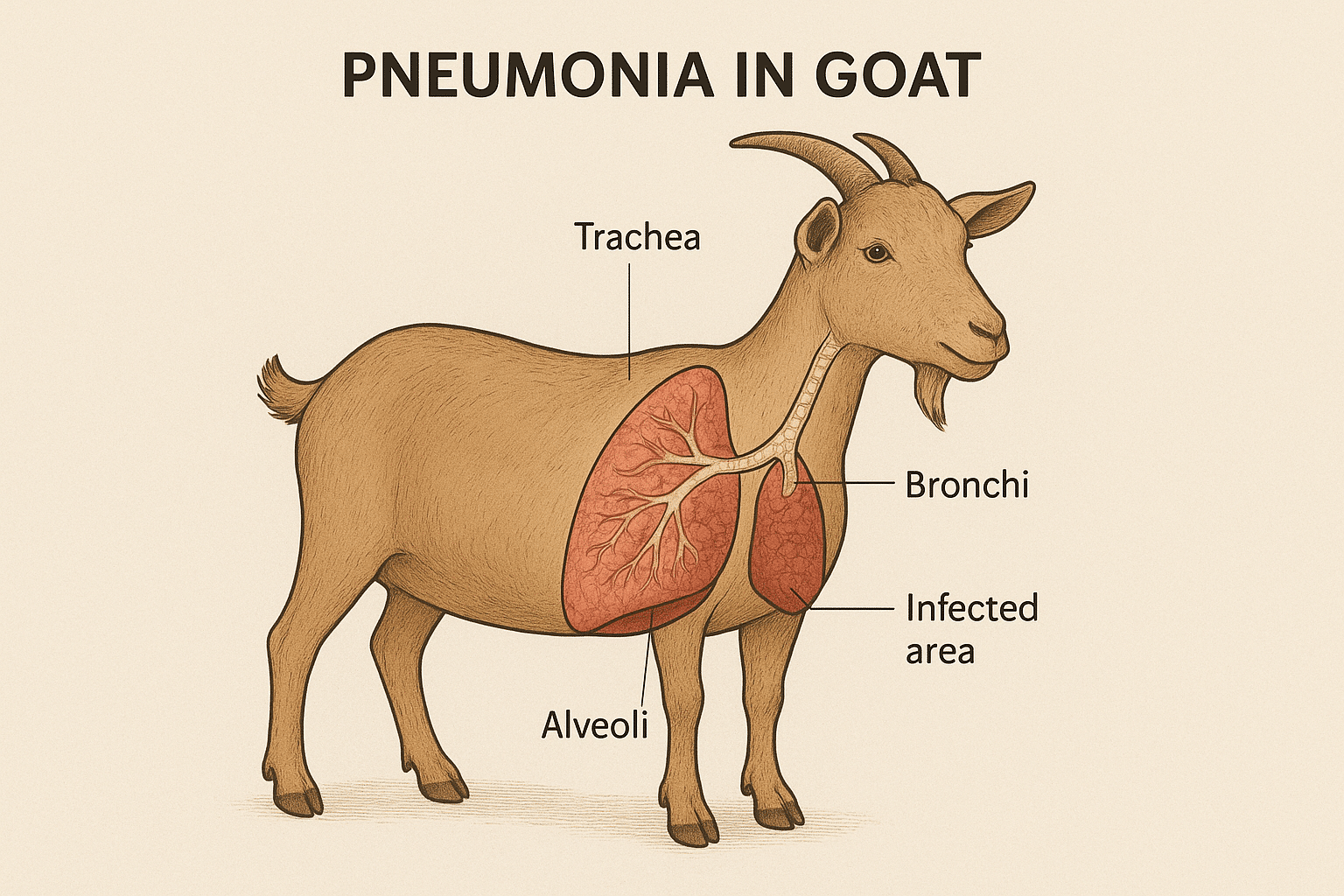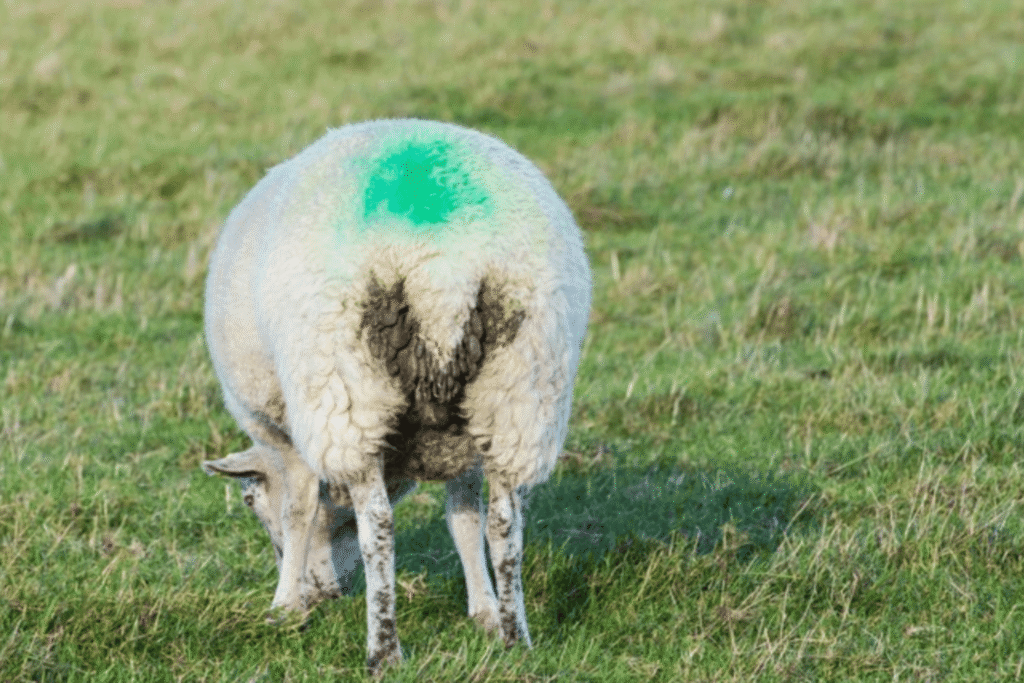Pneumonia in ruminants is an inflammation of the lungs caused by viral, bacterial, parasitic agents, or even stress. Pneumonia occurs when infectious or non-infectious agents such as bacteria, viruses, or parasites cause the lungs of goats to become inflamed. It can also cause inflammation in the larger breathing tubes, called bronchopneumonia, or swelling of the lining around the lungs, called pleuropneumonia.
Pasteurella multocida and Mannheimia haemolytica are the most common causes of respiratory diseases like pneumonia. These pathogens can trigger outbreaks of acute pneumonia in animals of all ages, though young animals are often the most affected. Respiratory infections caused by these bacteria are commonly linked to poor management practices, secondary infections, or situations involving severe stress.
Pneumonia is the second most common cause of death in goats and sheep. These animals have relatively small lungs, especially goats. Because of their small lung size, they have difficulty surviving respiratory diseases like pneumonia. The disease can cause sudden death due to severe swelling or blockage in the respiratory tract
Though bacteria and viruses can both cause pneumonia in goats and sheep, their causes, symptoms, and treatments are slightly different from each other. That’s why we discuss both of them separately.
Cause of Pneumonia in Goat and sheep
Pneumonia in sheep and goats is usually caused by a combination stress, infection, or lung parasites. bacterial and viral infection is main cause of pnamunia. Several viruses can cause pneumonia, Like parainfluenza virus type-3 (PI-3), adenovirus, respiratory syncytial virus, and in goats, the caprine arthritis and encephalitis (CAE) virus. Bacteria are also common causes. The most important ones include Mannheimia haemolytica, Pasteurella multocida, Haemophilus species, Chlamydia species, Salmonella species and Mycoplasma species.
Transportation Stress: Long trips, sudden changes in surroundings, and bad weather during transport can weaken animals’ immune systems, making them more likely to get sick.
Viral Infections: Viruses like respiratory syncytial virus (RSV) and parainfluenza virus can weaken the lungs and make it easier for bacteria to cause infections.
Lung Parasites: Lungworms and other parasites can damage the lungs, causing inflammation and creating a higher risk of bacterial infections.
Previous Bacterial Infections: If goats/sheep have had bacterial infections before, their lungs may still be weak. This makes it easier for bacteria like Pasteurella multocida and Mannheimia haemolytica to cause pneumonia.
Poor Housing Conditions: Dirty, damp, or poorly ventilated housing puts stress on the goats’ lungs and creates a perfect environment for germs to grow.
Sudden Environmental Changes: Quick changes in temperature, humidity, or weather can stress young goats and lower their immunity.
General Stress: Any kind of stress—such as weaning, mixing with new animals, or sudden management changes—can weaken the immune system and make animals more likely to develop pneumonia.
Symptoms of Pneumonia in Goat and sheep
Symptoms of pneumonia in goats and sheep include fever, painful coughing, difficult breathing, and nasal discharge. However, bacterial pneumonia is often discovered only after an animal dies suddenly and a necropsy is performed, with signs then appearing in other animals.
Respiratory problems in sheep and goats can present in several ways, including dyspnea (labored or difficult breathing), which may follow minor exertion or increased temperature as respiratory reserve decreases. Nasal and ocular discharge may result from irritants such as dust, ammonia vapor, or flies, but can also signal viral infection of the upper respiratory tract and may precede pneumonia. Persistent, forced coughing caused by pneumonia in young animals can even contribute to rectal prolapse. Lungworm infections are often unnoticed; however, heavy infestations can cause coughing that typically improves after anthelmintic treatment, as lungworms are susceptible to most modern drenches.
Necropsy (surgical examination of dead animal) findings vary depending on the cause of pneumonia. In bacterial pneumonias, the anteroventral lobes of the lungs are most affected, while viral and Mycoplasma pneumonias may involve all lobes, with secondary bacterial invasion common in the anteroventral areas. Lungworm lesions appear as grey-green nodules in the caudal lobes and may include visible tangles of white, threadlike worms in mucus-filled airways. Aspiration pneumonia usually leads to rapid decline and death, with necropsy showing severe damage—often more pronounced in one anterior lung lobe—characterized by consolidation and liquefaction. In goats with CAE-associated pneumonia, clinical signs typically develop only in older animals, and necropsy reveals grey, firm lungs. Proper diagnosis may require nasal swabs for virus testing, blood samples for serology, and submission of affected lung tissue for histology and microbiology.
Treatment for Pneumonia in Goats and Sheep
Pneumonia treatment when suspected is possible with antibiotics like oxytetracycline, trimethoprim sulpha. these are generally more effective than narrow-spectrum drugs like procaine penicillin. In valuable animals, non-steroidal anti-inflammatory drugs such as flunixin meloxicam, meglumine, ketoprofen, or tolfenamic acid may also be helpful.
Meloxicam is anti-inflammation drug used to reduce inflammation, fever and pain. It is not used to cure infection so it should be used with anti-biotics for pneumonia.
Sick animals should have easy access to feed and water, which at sea may require separating them from pen mates and moving them to hospital pens. If lungworm is a concern, anthelmintic drenches should be given. Animals that are severely affected and unlikely to recover should be euthanized without delay.
When to Seek Veterinary Care
Always consult a veterinarian for an accurate diagnosis and treatment plan, especially when dealing with valuable animals or widespread outbreaks. For animals that are severely affected and unlikely to recover, euthanasia should be considered promptly as a compassionate option. Veterinary guidance is crucial, as the effectiveness of medications can vary depending on the specific bacteria involved, and using multiple antibiotics at the same time can reduce their overall effectiveness.
For effective goat and sheep care, it is very important to pay attention to nutrition. Pneumonia makes the animal very weak. Poor nutrition makes it difficult for the animal to recover quickly. Here are some nutritional options that can be used during pneumonia to help your animal stay healthy and fight against the virus or bacteria.
Prevention of Pneumonia in Goat and Sheep
Preventing pneumonia in goats and sheep relies heavily on strong management practices that reduce stress and support overall respiratory health. Clean, dry, and well-ventilated housing helps reduce dust, ammonia, and moisture that irritate the lungs and make animals more vulnerable to disease. Providing good nutrition, including enough essential minerals, helps strengthen their immune system, and making sure newborns get high-quality colostrum gives them a strong start. Reducing stress—whether from overcrowding, sudden weather changes, or long transport—also plays a big role in keeping respiratory problems from developing.
Strong health monitoring and biosecurity practices are just as important. Animals showing signs of illness should be separated right away, and any new or returning animals should be quarantined before joining the flock or herd. Regular parasite control helps prevent lungworm infections, which can make pneumonia more likely. In areas where vaccines are available for respiratory diseases like Pasteurella or Mannheimia, following the recommended vaccination schedule can add an extra layer of protection. By combining good housing, nutrition, stress reduction, parasite control, and veterinary guidance, you can greatly lower the risk of pneumonia in goats and sheep.
Conclusion
Pneumonia in goats and sheep remains one of the most challenging health problems faced by small ruminant farmers. Because the disease often develops from a combination of stress, infection, and environmental factors, successful control requires more than just medication. Early recognition of symptoms, timely veterinary treatment, and strong management practices all play an equally important role. By improving housing conditions, maintaining good nutrition, reducing stress, and following proper vaccination and parasite-control programs, farmers can greatly reduce the impact of respiratory disease in their herds. With consistent attention to animal welfare and close collaboration with a veterinarian, the risk of pneumonia can be minimized and recovery outcomes can improve significantly.
FaQs of Pneumonia in goats and sheep?
What are the early signs of pneumonia in goats?
The earliest signs are often subtle. A goat may seem quieter than usual, eat less, or separate from the herd. As the infection progresses, you may notice fever, a soft or dry cough, watery eyes, nasal discharge, and faster or more effortful breathing. Many goats hold their head low or stretch their neck to make breathing easier.
What are the signs of “silent” or hidden pneumonia in goats?
Silent pneumonia occurs when the infection is present but outward signs are mild or inconsistent. These goats may not cough at all. Instead, you might see reduced appetite, slow movement, reluctance to keep up with the herd, mild fever, and occasional rapid breathing. Often, producers only notice the problem when the goat suddenly worsens.
Which antibiotics are commonly used to treat pneumonia in goats?
Several antibiotics are used depending on severity and the suspected cause. Oxytetracycline, tylosin, ceftiofur, and sometimes long-acting macrolides are typical choices. A veterinarian selects the drug based on the animal’s condition, weight, age, and the likely pathogens involved. Correct dosing and full treatment duration are essential for recovery.
How do veterinarians treat pneumonia in goats?
Treatment usually includes an appropriate antibiotic. Anti-inflammatory medication for fever and pain, and supportive care such as hydration and good ventilation. Severely affected goats may require vitamin supplementation, nutritional support, and stress reduction. Early intervention greatly improves outcomes.
What are the main stages of pneumonia progression in goats?
Pneumonia follows a fairly predictable path:
Early congestion: The lungs fill with fluid and inflammation begins.
Active infection: Fever, coughing, and labored breathing become noticeable.
Lung consolidation: The affected parts of the lung become firm and lose their normal function.
Resolution: With treatment, inflammation decreases and lung tissue gradually heals, though scarring may remain.
How long should antibiotic treatment last for pneumonia?
Most goats need 5–7 days of antibiotic therapy, but some require longer depending on the response. Stopping treatment too early can cause relapse or resistance. Veterinary guidance is important to determine the correct duration.
Can pneumonia in goats be viral or bacterial? How do you tell?
Both forms occur. Viral pneumonia typically starts with mild signs and spreads easily through the herd. Bacterial pneumonia tends to appear suddenly and more severely, with high fever and thick nasal discharge. Laboratory testing is the only way to confirm the exact cause, but veterinarians make practical decisions based on symptoms and herd history.
Does nebulization help goats with pneumonia?
Nebulizers can help relax the airways and improve breathing comfort in moderate to severe cases. However, they do not cure the infection on their own. They work best when used alongside antibiotics and proper medical care. They are especially helpful for kids or goats with thick mucus congestion.
Can humans catch pneumonia from goats?
Most pneumonia cases in goats are not contagious to humans. However, certain bacteria—especially those associated with poor ventilation or heavy manure buildup—can pose respiratory risks to people working in close quarters. Good hygiene, proper barn airflow, and handwashing reduce these risks significantly.
How much penicillin is typically given to a goat with pneumonia?
Traditional procaine penicillin G is often dosed at 1 mL per 100 lbs (approximately 3,000 units per pound) given once daily, but dosage can vary depending on the formulation and severity. Treatment generally continues for at least one day past full improvement. A veterinarian should always confirm dose and duration.
How do veterinarians diagnose pneumonia in goats?
Diagnosis is based on physical examination, listening for abnormal lung sounds, and checking temperature and respiratory rate. In advanced cases, chest X-rays or ultrasound help evaluate the extent of lung involvement. Some clinics also collect airway samples to identify the bacteria responsible, guiding more precise treatment.



